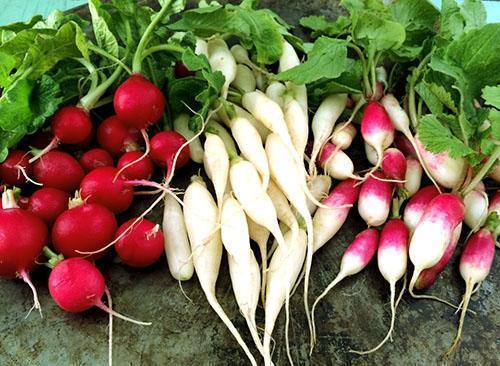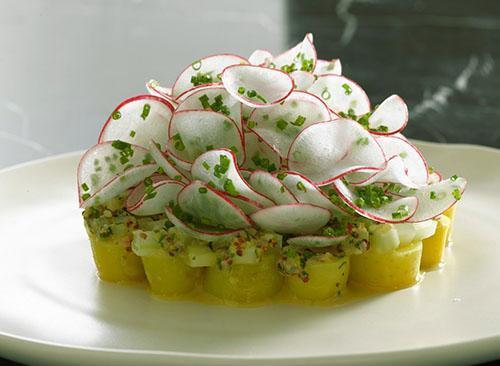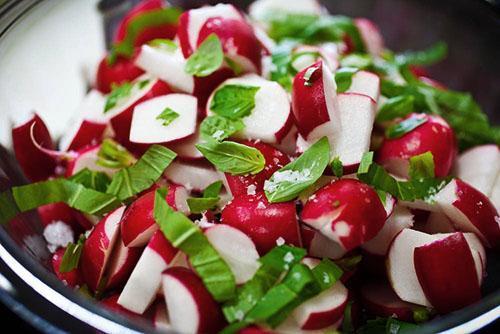The benefits and harms of garden radishes
 Among the early vegetables, radish is one of the first in popularity. And this is not surprising, because only green onions and some other green crops, but far from root crops, can boast of such early maturity and a friendly harvest from neighbors in the garden.
Among the early vegetables, radish is one of the first in popularity. And this is not surprising, because only green onions and some other green crops, but far from root crops, can boast of such early maturity and a friendly harvest from neighbors in the garden.
Round and elongated radishes are used in all kinds of snacks, salads, cold soups and other dishes. At the disposal of gardeners radish varieties with white, pink, red and even deep purple and yellow roots. But not only the variety of species and short ripening times attract attention to this culture, but the properties of radish useful for the body.
The juicy pulp of root vegetables, which has a refreshing sweetish taste with a pleasant pungency, is saturated with active nutrients, the deficiency of which is experienced by the human body after winter.
What vitamins are in radishes? Is this vegetable useful for everyone, and what is the best way to choose a radish and eat it?
Read also the article in the topic: what is the use of radishes?
Vitamin composition of radish and its calorie content

The calorie content of radish is very low, 100 grams of root crops contain from 15 to 20 kcal. At the same time, the nutritional value is included in 100 grams of the product:
- 1, 2 grams of protein;
- 0.1 grams of fat;
- 3.4 grams of carbohydrates;
- 3.1 grams of sugars;
- 1.6 grams of dietary fiber;
- 93 grams of water;
Also in the composition of the pulp and greens of radish there are minor amounts of organic acids, starchy substances and ash.
 The macronutrient composition of radish roots is determined by the high content of potassium, calcium and magnesium, phosphorus and sodium. Trace elements are represented by iron, zinc, copper and iodine, boron and manganese. And mustard oil, which has antiseptic properties, gives the radish a recognizable taste.
The macronutrient composition of radish roots is determined by the high content of potassium, calcium and magnesium, phosphorus and sodium. Trace elements are represented by iron, zinc, copper and iodine, boron and manganese. And mustard oil, which has antiseptic properties, gives the radish a recognizable taste.
How to choose the most beneficial radish for the body?
 To maximize the health benefits of radishes in a salad or okroshka, it is important to choose firm, healthy roots with smooth skin. Radish quickly loses its juiciness, the root crop becomes sluggish, soft, and the amount of nutrients in it decreases. If black spots are visible on the skin of even a hard root vegetable, this is the first sign of the development of mold fungi. You should not wait for pleasure or benefits when eating a dish made from such radish, but harm is quite possible. Therefore, the freshness of a radish is a decisive factor in its health.
To maximize the health benefits of radishes in a salad or okroshka, it is important to choose firm, healthy roots with smooth skin. Radish quickly loses its juiciness, the root crop becomes sluggish, soft, and the amount of nutrients in it decreases. If black spots are visible on the skin of even a hard root vegetable, this is the first sign of the development of mold fungi. You should not wait for pleasure or benefits when eating a dish made from such radish, but harm is quite possible. Therefore, the freshness of a radish is a decisive factor in its health.
Do not forget that the tops of this culture are no less saturated with substances valuable for the body than root crops. It is better to use it for food immediately after collection, since the foliage will wither in a matter of hours.
Useful properties of radish
 Radish roots and tops contain extremely few calories, but they are rich in active substances and dietary fiber, which gives reason to talk about the usefulness of this vegetable for many problems associated with digestion and absorption of food. Root vegetables included in the composition of the dishes activate intestinal peristalsis, contributing to the timely release of the digestive system and producing a mild laxative effect. Radish greens, from which the infusion is made, are no less useful for constipation.
Radish roots and tops contain extremely few calories, but they are rich in active substances and dietary fiber, which gives reason to talk about the usefulness of this vegetable for many problems associated with digestion and absorption of food. Root vegetables included in the composition of the dishes activate intestinal peristalsis, contributing to the timely release of the digestive system and producing a mild laxative effect. Radish greens, from which the infusion is made, are no less useful for constipation.
Radish, whose calorie content is very low, has long been respected by people who want to get rid of extra pounds with health benefits.Dietary fiber can help with this. Passing through the intestines, fiber cleans it out, removing accumulated toxins. The glycosides contained in radishes have an irritating effect, promote the production of gastric juice and the speedy digestion of food.
Radish is useful for patients suffering from heart and vascular diseases. Cholesterol accumulating on the walls of blood vessels impairs their patency and elasticity, which negatively affects the supply of blood to tissues and organs and leads to serious health problems. Radish with a calorie content lower than that of many other vegetable crops, like its closest relatives: radish, horseradish, mustard and turnip, prevents not only obesity, but also the accumulation of cholesterol, and the development of atherosclerosis.
There are substances in radishes that have a positive effect on blood sugar levels. Therefore, this vegetable can and even should be included in the menu of people with a tendency to diabetes or already suffering from this serious illness.
 The skins of brightly colored radish roots contain natural anthocyanins, which, according to recent studies, actively oppose the development of cancer cells. With the advent of dark purple varieties, the beneficial properties of radish in terms of fighting cancer only increase.
The skins of brightly colored radish roots contain natural anthocyanins, which, according to recent studies, actively oppose the development of cancer cells. With the advent of dark purple varieties, the beneficial properties of radish in terms of fighting cancer only increase.
Thanks to phytoncides, radish can be used as a natural and very tasty remedy to fight infections, including seasonal colds and the accompanying bronchitis, rhinitis and laryngitis. Radish juice, like radish juice, can help with coughs, nasal congestion and other unpleasant symptoms. Vitamin C will energize and give strength to fight ailments.
It is interesting that you can take advantage of the beneficial properties of radish for cosmetic purposes. Root gruel will nourish the skin with moisture, have a tonic and whitening effect, and will also help to cope with inflammatory processes. Vitamin E present in radishes activates skin regeneration and rejuvenation.
 It is common knowledge that radish root vegetables are indispensable in cold summer soups and snacks. It is an excellent ingredient for salads, a vitamin supplement and part of a garnish for meat dishes and potatoes. Mostly radishes are eaten raw, since during heat treatment, root crops lose most of the useful properties of radishes, and their appearance and juicy consistency.
It is common knowledge that radish root vegetables are indispensable in cold summer soups and snacks. It is an excellent ingredient for salads, a vitamin supplement and part of a garnish for meat dishes and potatoes. Mostly radishes are eaten raw, since during heat treatment, root crops lose most of the useful properties of radishes, and their appearance and juicy consistency.
 Few people know that radishes can be pickled and such snacks will become a real decoration of the table in winter. Even less often they pay attention to greens, and in fact the useful properties of radish tops are no less than those of root crops. This part of the plant in a young fresh form is used for okroshka and salads. You can save the tops for the winter in the form of a sauce, where olive oil, salt, spices and crushed walnuts or pine nuts are added along with chopped herbs.
Few people know that radishes can be pickled and such snacks will become a real decoration of the table in winter. Even less often they pay attention to greens, and in fact the useful properties of radish tops are no less than those of root crops. This part of the plant in a young fresh form is used for okroshka and salads. You can save the tops for the winter in the form of a sauce, where olive oil, salt, spices and crushed walnuts or pine nuts are added along with chopped herbs.
Is radish good for everyone?
 With all the uniqueness of the composition and set of useful properties, radishes cannot be considered a crop for general use. In some cases, instead of the expected health benefits, radishes can cause poor health.
With all the uniqueness of the composition and set of useful properties, radishes cannot be considered a crop for general use. In some cases, instead of the expected health benefits, radishes can cause poor health.
This is due to the presence of vegetable glycosides in root crops and, in part, in foliage, which irritate the gastric mucosa and cause active acid production. With increased acidity, pancreatitis and cholecystitis, as well as with gastritis and gastric ulcer, dishes made from fresh radish can provoke an unwanted aggravation.
Everyone can assess the benefits or harms of radishes for their own health, but if there are contraindications, you should not think that you should unconditionally abandon the early vegetable. Light-colored and white varieties of radish have a softer taste and effect, and, for example, there are practically no glycosides in daikon.
Thanks for the helpful information about radish.I was especially surprised that radishes can be pickled and greens can be processed into a vitamin paste. In the summer, when cucumbers and tomatoes appear, radishes give way to them on the table. Those root crops that remain in the garden will not go into winter storage. But you can preserve and then surprise your family. And another news for me was that if the radish wilted, it means that there is less benefit from it. I believed that in a sluggish root crop, only water becomes less water, and the juice is thicker. Now I know that I need to organize proper storage and use only springy vegetables.